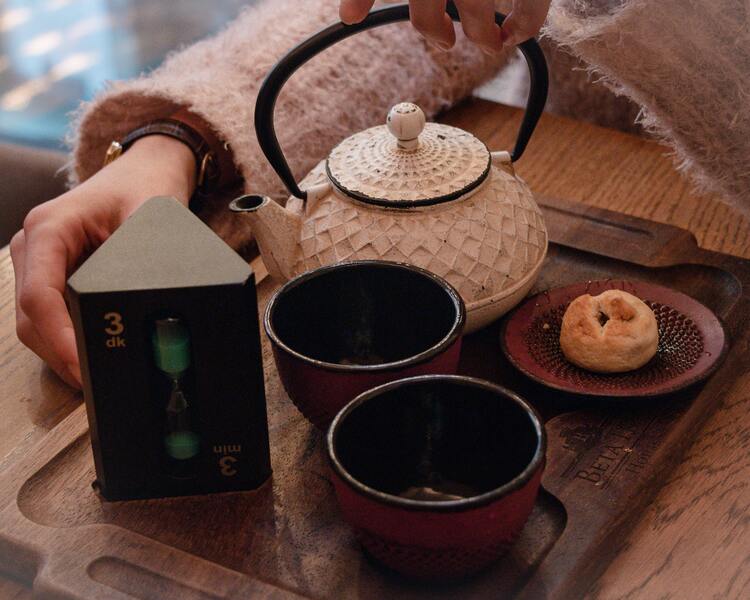Wakoucha, a black tea from Japan, is truly a hidden gem that you won’t want to miss.
Traditionally, Japan is widely recognized for its green tea production; however, black tea, like Wakoucha is gaining popularity thanks to its remarkable qualities.
Wakoucha, which translates to “Japanese black tea,” is produced using the same Camellia sinensis plant as green tea. The difference in color, taste, and aroma lies in black tea’s extensive oxidation process.
In this article, we immerse into this tea that is slowly gaining recognition, even though it is still relatively unknown outside of Japan.
Please note: This article contains affiliate links, meaning I may earn a commission if you make a purchase by clicking a link. Of course, this comes at no extra cost to you and helps me keep offering readers solid information.

History of Wakoucha
Wakoucha has a rich history dating back to the Meiji era in Japan. During this time, the Japanese government aimed to develop and promote its tea industry. They encouraged tea farmers to explore and produce new types of teas, leading to the birth of Wakoucha, a unique Japanese black tea.
In the late 19th century, Tada Motokichi played a significant role in popularizing Wakoucha. Motokichi, a Japanese tea master, fine-tuned Wakoucha’s production process while experimenting with methods—his innovative techniques and dedication to producing high-quality tea led to its widespread recognition and enjoyment.
As you learn about this tea, it’s important to understand its roots in Japanese tea culture. Japan has long been known for its world-famous green teas, such as Sencha and Matcha, cultivated for centuries. The emergence of Wakoucha marked a shift in the Japanese tea industry, introducing a new variety of tea.
Cultivation and Production
Tea Cultivars
When it comes to this black tea, several tea cultivars are used for its production. Yabukita, Benihomare, Benihikari, and Benifuuki are some of the most common cultivars. These cultivars are known for their distinct flavor profiles, which differ from the typical Camellia sinensis plant. The Assamica variety, with its bold and malty characteristics, is also often used in Wakoucha production.
Let me explain the difference between a variety and a cultivar for reference. We have the tea plant. The plant has two natural variations, one native to China (Sinensis) and one native to India (Assamica). Since variations are natural, they propagate through seeds. The Assamica variation is mainly used in black teas.
Then, experts developed a cultivar from one of these variations (a plant developed to yield specific characteristics; cultivars propagate through cuttings).
Growing Regions
As you explore Wakoucha, you’ll notice that its cultivation is concentrated in a few key regions throughout Japan. Among these regions, Shizuoka, Kagoshima, and Asamiya are arguably the largest and most renowned tea production areas.
- Shizuoka: Recognized as Japan’s top tea-producing region, Shizuoka is home to numerous farmers nurturing different tea cultivars. The area’s mild climate and rich volcanic soil contribute significantly to the distinctive flavors of Wakoucha produced here.
- Kagoshima: Situated in southern Japan, this region boasts a warm climate and mild winters, perfect for cultivating tea. Kagoshima’s Wakoucha teas are sought after for their mix of sweet and savory notes.
- Asamiya: With a history dating back over a thousand years, Asamiya is another well-known tea production area. The region’s mountainous terrain and fertile soil create ideal conditions for growing tea plants, allowing farmers to produce high-quality Wakoucha with a unique taste profile.
Processing Techniques
The production of Wakoucha stands distinct from other Japanese teas mainly due to its processing techniques. Here’s an overview of the steps involved in creating this unique black tea:
- Withering: After harvesting, the fresh tea leaves are left to wither, reducing their moisture content and allowing them to soften. This process is crucial in developing the tea’s complex flavors.
- Rolling: The withered leaves are delicately rolled to break down their cell walls. This action releases essential oils and enzymes that develop the tea’s taste.
- Oxidation: Unlike Japanese green teas steamed to prevent oxidation, Wakoucha requires an oxidation process. The rolled leaves are exposed to air, allowing enzymes to react with various compounds, giving the tea its color and flavor. The level of oxidation varies depending on the desired end product.
- Drying: Finally, the oxidized tea leaves are dried to halt further oxidation and preserve the tea’s flavor and quality. Drying also prevents the growth of bacteria, ensuring your Wakoucha remains fresh and safe to consume.
To summarize, this exceptional Japanese black tea’s cultivation is rooted in a variety of regions, cultivars, and processing techniques.

Taste and Flavor Profile
Comparison to Green Teas
Compared to green teas, which are generally characterized by their grassy, vegetal flavors and strong umami notes, Wakoucha has a fruitier, sweeter taste with a hint of honey-like notes.
The level of astringency in this black tea is also much lower, making it a smoother tea to sip. This is primarily due to the oxidation process, which produces these fruity and subtly sweet flavors.
Comparison to Chinese and Indian Black Teas
Wakoucha also contrasts distinctly with Chinese and Indian black teas in taste and aroma. While Chinese black teas often have malty and fruity flavors with distinct notes like chrysanthemum and clove, Indian black teas lean more towards bold, robust, and malty tastes.
Wakoucha has spice and toasted notes. These flavors aren’t as prominent as in Chinese and Indian black teas but provide a pleasant, subtle complexity.
In addition, the aroma of Wakoucha exhibits a more delicate profile compared to the strong and sometimes pungent scent of Chinese and Indian black teas. The aroma of Japanese black tea is often described as gentle with a slight sweetness.
Brewing and Consumption
Brewing Techniques
You can use various methods to achieve the desired taste when brewing this black tea. Start with fresh, cold water, and heat it to a temperature between 90-95°C (194-203°F). Generally, a ratio of 5 grams of tea leaves to 250 ml of water is a good starting point. Adjust the quantity to your taste. Place the tea leaves into a teapot designed for black tea, like the Japanese kyusu.
For the best results, preheat the teapot by swirling a small amount of hot water before brewing. This helps maintain a consistent steeping temperature. Pour the hot water over the tea leaves and allow them to steep for 2-3 minutes.
If you prefer a stronger flavor, you may increase the steeping time to 5 minutes. Do not let the water’s temperature drop too much during steeping. It is essential to release the full range of flavors and nuances.
Pairing with Food
When it comes to pairing Wakoucha with food, your options are plenty. Wakoucha has a smooth, mellow flavor with subtle sweetness, making it an excellent choice for sweet and savory dishes.
Sweet dishes
- Pastries
- Fruit tarts
- Chocolate desserts
Savory dishes
- Mild cheeses
- Sandwiches
- Salads
Since the tea is naturally sweet, you don’t need to add sugar to your cup. However, if you like, you can still experiment with different sweeteners to enhance the flavor profile. Honey, agave syrup, and other natural sweeteners work well with black teas.
Consider adding a dash of milk, as it blends well with the tea’s natural creamy taste. The presence of milk can also bring out a pleasant balance between the tea’s sweetness and the savory notes of your chosen food pairing.

Challenges and Opportunities
Market Demand and Export
As a lover of Japanese black tea, or Wakoucha, you might know the growing market demand and export opportunities. While Japan has been famous for its green teas, such as Sencha, Matcha, Gyokuro, and Bancha, Wakoucha is gaining popularity in the Western market. With a focus on high-quality production and unique terroir, Japanese black tea is now competing with imports from China, India, and Sri Lanka.
However, entering the global market has its own set of challenges. Tea farmers in Fujieda and other regions need to meet the increasing demand and compete with imported black tea, like Ceylon and Sri Lankan varieties, while maintaining the quality of Japanese black tea. Innovative production methods and organic practices can help differentiate this tea from its competitors and attract international consumers.
Innovation in Tea Production
Tea industry experts recognize the need for innovation in tea production processes to improve Wakoucha. Since black tea production is relatively new in Japan compared to green tea, there’s room for exploring new withering, oxidation, rolling, and drying techniques.
Some suggestions for innovation in tea production include:
- Withering: Allowing better airflow during initial withering can help bring out the best flavors in Wakoucha.
- Oxidation: Experimenting with different oxidation levels can help achieve a variety of taste profiles.
- Rolling: Employing new rolling techniques can improve the texture and appearance of the tea leaves.
- Drying: Optimizing the drying process can enhance the stability and aroma of the finished product.
Another potential growth area is the production of aged black tea, which could provide a unique offering within the tea market and further expand opportunities for Japanese black tea producers.
Buying Recommendations
If you want to try Japanese black tea and are considering buying it online, please consider the following recommendations.
Happa Organic Japanese Black Tea



Frequently Asked Questions
What are the health benefits of Japanese black tea?
Japanese black tea, like other teas, contains antioxidants that can help improve your overall health. Drinking this tea regularly may help lower your risk of heart disease and stroke and potentially aid in weight loss and digestion. However, it is important to remember that these benefits may vary from person to person.
How does Wakoucha differ from other Japanese tea blends?
This Japanese black tea is fully oxidized, unlike green and partially oxidized teas commonly found in Japan. This oxidation process gives Wakoucha its distinct rich and malty flavor profile that sets it apart from other Japanese teas.
What are some popular Japanese black tea brands?
Some popular Japanese black tea brands include Benifuuki, Yame Black, and Ine Black Tea. These brands offer various blends, allowing you to explore and find your favorite taste.
How is Wakoucha typically prepared?
You should use about 3 grams of tea leaves per 200ml of water to prepare the tea. Heat the water to about 90-95°C (194-203°F) and steep the tea leaves for 3-4 minutes. This will allow the flavors to properly develop and provide you with a delicious cup of Japanese black tea.
Can you add milk to Japanese black tea?
While it is not traditional to add milk to Wakoucha, there is no strict rule against it. Experimenting with milk might give you a flavor combination you enjoy, so feel free to add milk to your Japanese black tea if you prefer.
What makes Wakoucha unique from Chinese black tea?
Wakoucha is unique from Chinese black tea as it often has a lighter and milder flavor. The production methods, tea cultivars, and terroir in Japan also contribute to Japanese black tea’s distinct taste and characteristics compared to its Chinese counterparts.

It was so fun to write about this Japanese black tea after comprehensively covering different types of Japanese green teas on the site.
Have you tried (or want to try) this tea?
More About Black Tea
The Process of Making Black Tea
What Does Black Tea Taste Like?
What Does Black Tea Taste Like?
What Does Assam Tea Taste Like?
What Does Darjeeling Tea Taste Like?
What Does Chai Tea Taste Like?